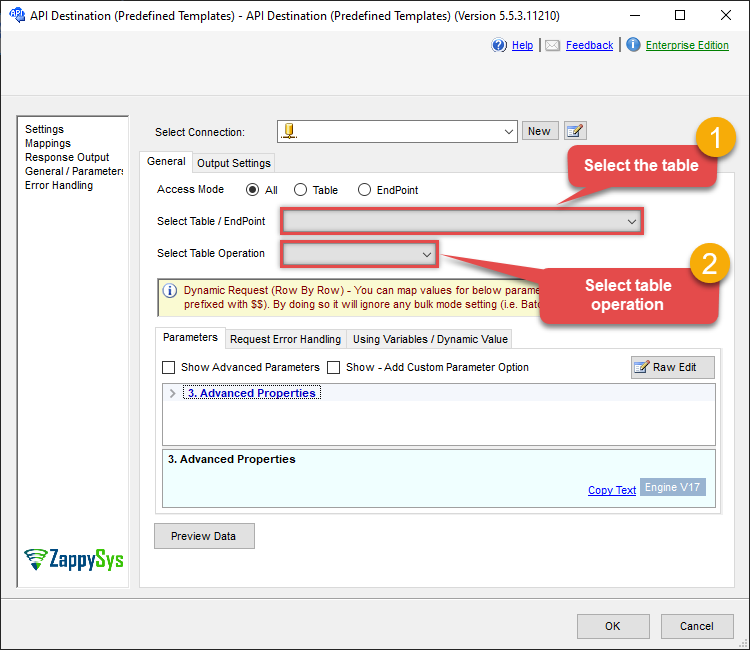Endpoint Create event
Name
create_event
Description
Related Tables
Parameters
| Parameter | Required | Options |
|---|---|---|
|
Name:
Label: CalendarId |
YES |
Output Columns
| Label | Data Type (SSIS) | Data Type (SQL) | Length | Description |
|---|---|---|---|---|
| Id |
DT_WSTR
|
nvarchar(50)
|
50 | |
| Status |
DT_WSTR
|
nvarchar(50)
|
50 | |
| Created |
DT_DBTIMESTAMP
|
datetime
|
||
| Updated |
DT_DBTIMESTAMP
|
datetime
|
||
| HtmlLink |
DT_WSTR
|
nvarchar(4000)
|
4000 | |
| iCalUID |
DT_WSTR
|
nvarchar(1024)
|
1024 | |
| eventType |
DT_WSTR
|
nvarchar(128)
|
128 |
Input Columns
| Label | Data Type (SSIS) | Data Type (SQL) | Length | Description |
|---|---|---|---|---|
| StartsOn |
DT_DBDATE
|
date
|
Use StartsOn OR StartsAt | |
| StartsAt |
DT_DBTIMESTAMP
|
datetime
|
Use StartsOn OR StartsAt | |
| StartsInTimeZone |
DT_WSTR
|
nvarchar(300)
|
300 | |
| EndsOn |
DT_DBDATE
|
date
|
||
| EndsAt |
DT_DBTIMESTAMP
|
datetime
|
||
| EndsInTimeZone |
DT_WSTR
|
nvarchar(300)
|
300 | |
| Kind |
DT_WSTR
|
nvarchar(300)
|
300 | |
| Attendees |
DT_NTEXT
|
nvarchar(MAX)
|
||
| Description |
DT_WSTR
|
nvarchar(4000)
|
4000 | |
| GuestsCanInviteOthers |
DT_WSTR
|
nvarchar(4000)
|
4000 | |
| GuestsCanModify |
DT_WSTR
|
nvarchar(4000)
|
4000 | |
| GuestsCanSeeOtherGuests |
DT_WSTR
|
nvarchar(4000)
|
4000 | |
| Location |
DT_WSTR
|
nvarchar(1024)
|
1024 | |
| Recurrence |
DT_WSTR
|
nvarchar(1024)
|
1024 | |
| Status |
DT_WSTR
|
nvarchar(50)
|
50 | |
| Summary |
DT_WSTR
|
nvarchar(300)
|
300 | |
| Transparency |
DT_WSTR
|
nvarchar(300)
|
300 | |
| Visibility |
DT_WSTR
|
nvarchar(300)
|
300 |
Examples
SSIS
Use Google Calendar Connector in API Source or in API Destination SSIS Data Flow components to read or write data.
API Destination
This Endpoint belongs to the Events table, therefore it is better to use it, instead of accessing the endpoint directly. Use this table and table-operation pair to create event:
| Required Parameters | |
|---|---|
| CalendarId | Fill-in the parameter... |

ODBC application
Use these SQL queries in your ODBC application data source:
Create event
Creates event
INSERT INTO Events(StartsAt, StartsInTimeZone, EndsAt, EndsInTimeZone, Summary,
Attendees, Description, Location, Status, Transparency, Visibility)
VALUES ('2021-11-26T16:30:50', 'Europe/Vilnius', '2021-11-27T16:30:50','Europe/Vilnius', 'This is an event',
null, 'My Description', 'Vilnius', 'confirmed', 'opaque', 'default')
WITH (CalendarId='YourCalendarId')
create_event endpoint belongs to
Events
table(s), and can therefore be used via those table(s).
SQL Server
Use these SQL queries in SQL Server after you create a data source in Data Gateway:
Create event
Creates event
DECLARE @MyQuery NVARCHAR(MAX) = 'INSERT INTO Events(StartsAt, StartsInTimeZone, EndsAt, EndsInTimeZone, Summary,
Attendees, Description, Location, Status, Transparency, Visibility)
VALUES (''2021-11-26T16:30:50'', ''Europe/Vilnius'', ''2021-11-27T16:30:50'',''Europe/Vilnius'', ''This is an event'',
null, ''My Description'', ''Vilnius'', ''confirmed'', ''opaque'', ''default'')
WITH (CalendarId=''YourCalendarId'')';
EXEC (@MyQuery) AT [LS_TO_GOOGLE_CALENDAR_IN_GATEWAY];
create_event endpoint belongs to
Events
table(s), and can therefore be used via those table(s).
